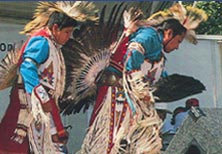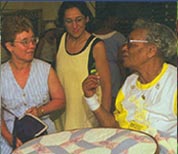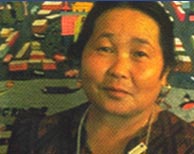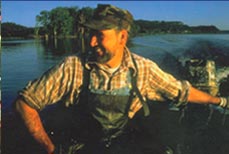|
|
Lesson 4.3: Hmong Textiles: Stories in Cloth
|
|
| Questions to be Answered |
| How does history become art? |
| Why use art to tell a story? |
| Have everyday objects made by immigrants in the past become symbols of ethnic groups in the present? |
|
- Use the illustration of Shoua Her’s Hmong story cloth reproduced here to provide an example of traditional ethnic artistry that tells a story. Ask students to identify what it might be. Have they ever seen anything like it? What do the pictures represent? Who do they think made it? How might it be used?
- Read the description of the story cloth to the students or reproduce it so they may read it themselves. Discuss students’ impressions of the piece before and after reading the description.
- List other objects in their experience that “tell a story.” Give them some examples if they are having a hard time thinking of objects: a quilt made out of scraps of worn-out clothing, the oldest part of a family home that has been added on to, an Easter egg with distinct patterns. (If possible, bring in one or two objects from your own family or from friends or colleagues.)
- Using Shoua Her’s needlework as a model, have students draw their own life history story cloth in the Hmong aesthetic style.
- Have students exchange their drawings. Call on students to interpret the drawings of their classmates. Then have the makers evaluate the interpretations in terms of accuracy, depth of meaning, and other criteria.
- Have students evaluate their classmates’ drawings in terms of how well they reproduced the Hmong aesthetic pattern illustrated in Shoua Her’s cloth. Discuss the features of that aesthetic pattern.
- Ask students to find an object around their home made by someone in their family. This could be a piece of needlework, a costume, a painting of an ancestor from “the old country.” Have them write a brief interpretation of the object: where it came from, who made it, why it was kept.
- Check out the Iowa Folk & Traditional Arts Roster and invite someone like Shoua Her into your classroom to discuss the making of a story cloth or story quilt or tapestry.
Seniors can identify traditional material culture from their own heritage that tells a story. Encourage seniors to bring items in to share and discuss. Find out if they know how to make such objects and can demonstrate the skill.
| |
| |
|
Photo |
|
|
|
| |
LESSON 4.3 |
|
| Shoua Her and her daughter, Choua, at the Smithsonian Festival. Mrs. Her’s daughter has grown up in Iowa; what kind of cloth story might she embroider? |
| |
|
PHOTO BY JEFF TINSLEY |
|
|
|
|









